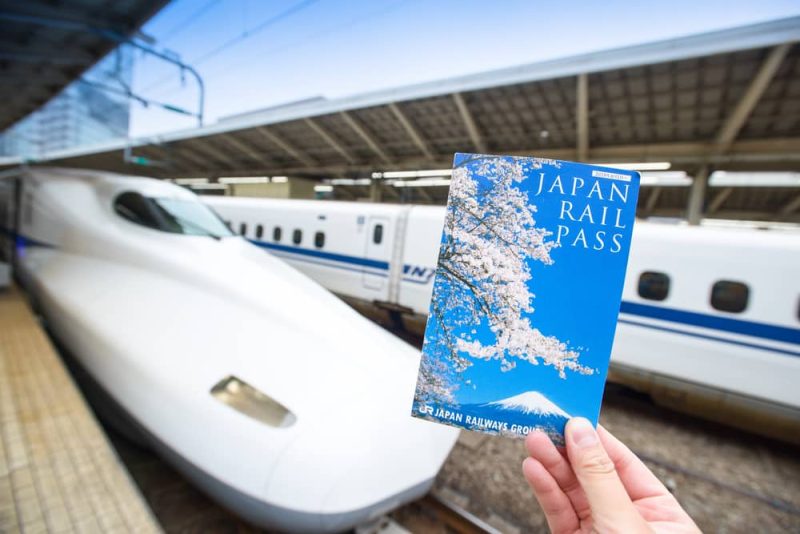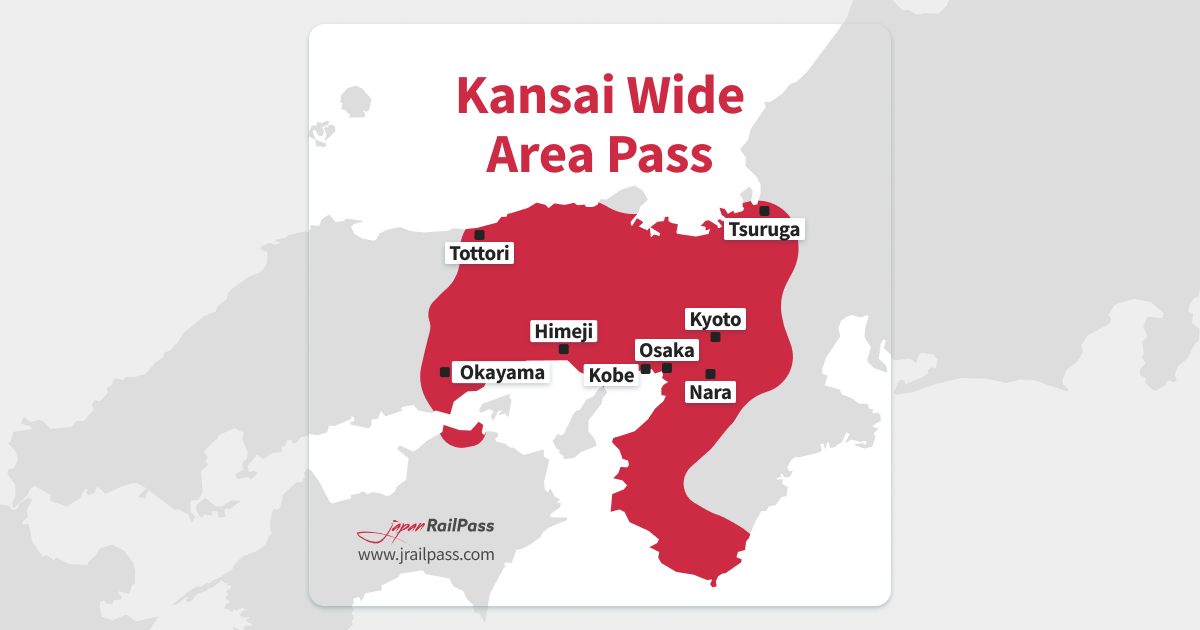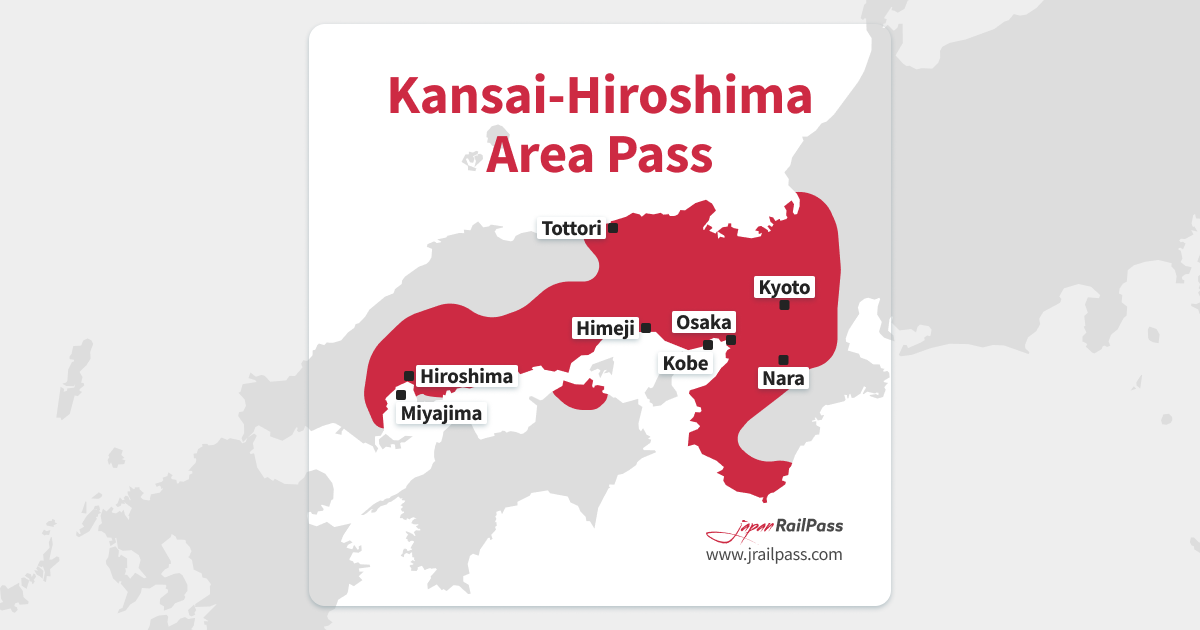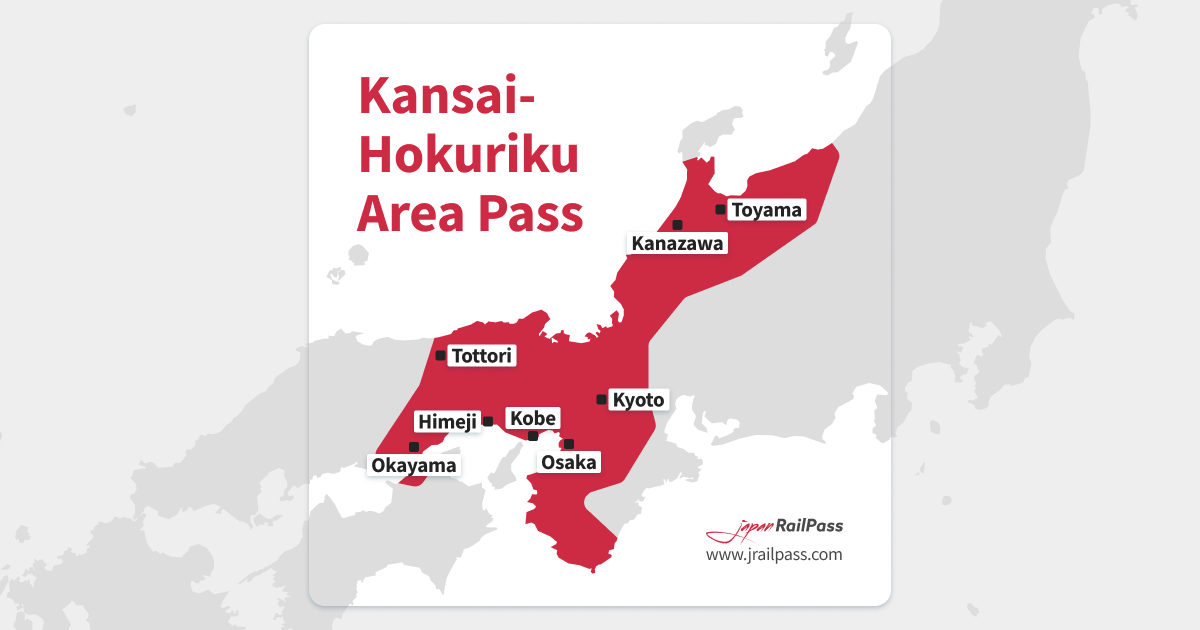A common question when traveling in Japan is whether a regional pass is better than the full national Japan Rail Pass.
Choosing the right rail pass can make a big difference, and can save you a lot of money.
In this guide, we compare the national Japan Rail Pass with several regional passes that cover the Kansai area and beyond.
We cover what each pass includes, how long they last, how much they cost, and which one is right for your trip.
Table of Contents
Coverage: Where can each pass take you
Below is a comparison of what’s included in each pass, to help you find the best fit for you.
Japan Rail Pass

The Japan Rail Pass gives you nationwide access to practically all JR-operated services:
- All Shinkansen lines
- All JR local, rapid, and limited express trains
- JR buses and ferry services (including the ferry to Miyajima)
- Airport transfers like the Narita Express and Haruka Express
- Cities covered: Tokyo, Osaka, Kyoto, Hiroshima, Fukuoka, Sapporo, and more
While the coverage offered by the full pass is extensive, remember that you’ll need to pay an additional fee for Nozomi and Mizuho trains.
Kansai Area Pass

The Kansai Area Pass includes:
- Unlimited travel on local, rapid, and special rapid JR lines within the Kansai region
- Haruka Express between Kansai Airport and Kyoto (2 reserved seats included)
- JR West buses between Kyoto Station, Takao, and Shuzan
- Free Ekirin Kun bike rental
- Three extra 1-day vouchers: the Kyoto Subway One-Day Card, Keihan 1-Day Kyoto Sightseeing Pass and Hankyu 1-Day Kyoto Line Free Pass
Please note that this pass does not cover Shinkansen or limited express trains (except the Haruka Express).
Kansai Wide Area Pass

The Kansai Wide Area Pass covers:
- Major cities like Osaka, Kyoto, Nara, and Kobe
- JR West local, rapid, and special rapid trains in Kansai
- Sanyo Shinkansen between Shin-Osaka and Okayama (non-reserved only)
- Haruka Express (Kansai Airport access)
- Limited Express trains (e.g., Kuroshio, Kinosaki, Maizuru)
- Kyoto Tango Railway and Chizukyu Express Line
- Select JR buses and Ekirin Kun bike rentals
Buy your Kansai Wide Area Pass
Kansai-Hiroshima Area Pass

The Kansai-Hiroshima Area Pass includes:
- All of the Kansai Wide coverage
- Extended westward access to Hiroshima and Miyajima
- Sanyo Shinkansen from Shin-Osaka to Hiroshima
- JR ferry to Miyajima
- Regional JR buses in Kyoto and Hiroshima
- Kyoto Tango Railway, Wakayama Railway
Does not include Hokuriku or Kanazawa
Buy your Kansai-Hiroshima Area Pass
Kansai-Hokuriku Area Pass

The Kansai-Hokuriku Area Pass offers:
- Coverage across Kansai, Hokuriku, and Okayama
- Sanyo Shinkansen (Shin-Osaka to Okayama)
- Hokuriku Shinkansen (Tokyo to Tsuruga section)
- JR lines in Kanazawa, Toyama, Fukui, Tsuruga
- IR Ishikawa Railway, Ainokaze Toyama Railway (partial access)
- Kyoto Tango, Noto, and Wakayama Electric Railways
- West Japan JR Bus and bike rentals
Does not include Hiroshima or Miyajima
Buy your Kansai-Hokuriku Area Pass
How long can you use each pass?
Each pass has different validity periods. All passes operate on calendar days, not 24-hour blocks. The first day counts fully, regardless of what time you start using the pass.
| Pass | Validity |
|---|---|
| Japan Rail Pass | 7, 14, or 21 consecutive days |
| Kansai Area Pass | 1 to 4 consecutive days |
| Kansai Wide Area Pass | 5 consecutive days |
| Kansai-Hiroshima Area Pass | 5 consecutive days |
| Kansai-Hokuriku Area Pass | 7 consecutive days |
Price comparison: Which pass is the best value?
You should check to make sure which pass offers you the best value. If you plan on seeing all of Japan, the national pass could be the best choice.
However, if you just want to see Kansai, one of the Kansai regional passes would probably make more sense. To decide which one is the best value, you’ll need to see which aligns best with your travel plans.
All 4 regional passes include 6 free online seat reservations. You can then make more reservations at the train station.
Children aged 6–11 get the pass for half price. Up to 2 infants (1 – 5) can travel free per adult or child pass.
| Pass | Price (Adult) | Days | Cost per Day | Region |
|---|---|---|---|---|
| Japan Rail Pass (7 Days) | ¥50,000 | 7 | ¥7,143 | Nationwide |
| Japan Rail Pass (14 Days) | ¥80,000 | 14 | ¥5,714 | Nationwide |
| Japan Rail Pass (21 Days) | ¥100,000 | 21 | ¥4,762 | Nationwide |
| Kansai Area Pass (1–4 Days) | ¥2,800 – ¥7,000 | 1-4 | ¥2,400 -¥1,575 | Kansai |
| Kansai Wide Area Pass | ¥12,000 | 5 | ¥2,400 | Kansai & Okayama |
| Kansai-Hiroshima Area Pass | ¥17,000 | 5 | ¥3,400 | Kansai & Hiroshima |
| Kansai-Hokuriku Area Pass | ¥19,000 | 7 | ¥2,715 | Kansai & Hokuriku |
Airport transfers: What’s included?
All 5 passes cover transport to Kansai Airport via the Haruka Express. Only the national Japan Rail Pass includes Narita and Haneda Airport transfers. This is convenient if you plan on flying into Tokyo.
| Airport | Japan Rail Pass | Kansai Area Pass | Kansai Wide Area Pass | Kansai-Hiroshima | Kansai-Hokuriku |
|---|---|---|---|---|---|
| Narita (NRT) | ✔️ | ❌ | ❌ | ❌ | ❌ |
| Haneda (HND) | ✔️ | ❌ | ❌ | ❌ | ❌ |
| Kansai Intl (KIX) | ✔️ | ✔️ | ✔️ | ✔️ | ✔️ |
Seat reservations and train access
The Japan Rail Pass and all regional passes (except the Kansai Area pass) allow you to reserve seats at no extra cost on trains that have reserved seat sections.
They also include access to ordinary class non-reserved cars. However, Green Car (First Class) and sleeper services are not included. You can get access to Green Car services by paying an extra charge, or if you opt for the premium JR Green Pass.
| Pass | Shinkansen Coverage |
|---|---|
| Japan Rail Pass | All nationwide Shinkansen lines |
| Kansai Area Pass | – |
| Kansai Wide Area Pass | Sanyo Shinkansen (Shin-Osaka to Okayama) only |
| Kansai-Hiroshima Area Pass | Sanyo Shinkansen (Shin-Osaka to Hiroshima), incl. Nozomi/Mizuho |
| Kansai-Hokuriku Area Pass | Sanyo (Shin-Osaka to Okayama) + Hokuriku Shinkansen (Tokyo to Tsuruga) |
How to choose the right rail pass for your trip
The right rail pass for your trip depends on where you’re going and how long you’ll be traveling.
If you’re staying within Kansai, the Kansai Area Pass offers the best value.
For trips that include Hiroshima or Miyajima, the Kansai-Hiroshima Area Pass gives you quick, convenient access via the Sanyo Shinkansen. If you’re heading north toward Kanazawa, Fukui, or Toyama, the Kansai-Hokuriku Area Pass is the better choice.
The Japan Rail Pass is the most flexible option if you’re planning a longer trip across multiple regions or want full access to all Shinkansen lines nationwide.
Osaka City Rail Passes
If you’re traveling in Kansai, it’s likely you’ll visit Osaka. The introduction of 3 digital travel passes for Osaka has made getting around much easier.
These passes offer flexible and cost-effective options. Here’s a breakdown:
Osaka Amazing Pass
The Osaka Amazing Pass is ideal if you plan to sight see intensively in a short time.
It provides unlimited rides on Osaka Metro, city buses, and several private railways.
This pass also includes free entry to around 40 attractions like Osaka Castle and the Umeda Sky Building.
With added discounts at shops and tours, it quickly pays for itself. Prices start at ¥3,500 for 1 day and ¥5,000 for 2 days.
Osaka Metro 26-hour and 48-hour Tickets
These digital tickets are perfect if you’re mainly focused on getting around the city with flexibility.
They allow unlimited rides on all Osaka Metro lines (except the Imazato BRT) for 26 or 48 hours from your first ride.
Alongside smooth transport, you’ll also enjoy discounted entry to 30 tourist attractions.
Prices are ¥1,100 for the 26-hour ticket and ¥1,800 for the 48-hour ticket (children half-price).
Osaka Smart Access Pass
This limited-time pass offers unbeatable value for travelers needing wider access.
Covering both JR West and Osaka Metro lines (including Yumeshima and Sakurajima stations near the Expo site) it’s a convenient way to explore beyond the city’s core.
Priced at just ¥1,200 (adult only), it’s valid until October 31, 2025, making it a smart choice for day trips or Expo visitors.
